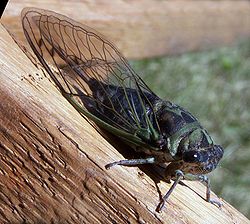- Tibicen
-
Tibicen 
Linne's cicada, Tibicen linnei Scientific classification Kingdom: Animalia Phylum: Arthropoda Class: Insecta Order: Hemiptera Family: Cicadidae Subfamily: Tibiceninae Genus: Tibicen
Latreille 1825Species See text
For the bird species, see Australian magpie.For the ancient Roman musician, see aulos.The Tibicen genus of cicadas are large-bodied Cicadidae appearing in late summer or autumn.[1] Like other members of the subfamily Cicadinae, they have loud, complex songs, even (in many cases) distinct song phrases.[2] Tibicen are the most common cicada in the United States. Unlike periodical cicadas, whose swarms occur at 13- or 17-year intervals, Tibicen species can be seen every year, hence their nickname "annual cicadas." The lifecycle of an individual, however, is more than a year. Nymphs spend two or three years feeding on tree roots before they emerge. Their annual reappearance is due to overlapping generations. Many other colloquial names exist for Tibicens: locust, dog day cicada, harvest fly, August dry bird, jar fly, bush cicada.
Tibicen cicadas are 1-2 inches long, with characteristic green, brown, and black markings on the top of the thorax, and tented, membranous wings extending past the abdomen. The fore pair are about twice the length of the hind pair. Males produce loud calls in the afternoon or evening (depending on the species) to attract females. These sounds, distinctive for each species, are produced by organs below the abdomen's base. These calls range from a loud buzz to a long rattling sound. Adults feed using their beak to tap into the xylem of plants. Nymphs feed from the xylem of roots.
Many animals feed on cicadas, which usually occurs during the final days when they become easy prey near the ground. One of the more notable predators is the cicada killer. This is a large wasp that catches the dog day cicada. After catching and stinging the insect to paralyze it, the cicada killer carries it back to its hole and drags it underground to a chamber where it lays its eggs in the paralyzed cicada. When the eggs hatch, the wasp larvae feed on the paralyzed, but still living, cicada.
Contents
References
- ^ "Cicadas of Michigan". University of Michigan Museum of Zoology. http://insects.ummz.lsa.umich.edu/fauna/Michigan_Cicadas/Michigan/Index.html. Retrieved 13 June 2011.
- ^ "Cicadas of the United States and Canada East of the 100th Meridian". Connecticut Entomological Society. http://www.insectsingers.com/100th_meridian_cicadas/index.html. Retrieved 13 June 2011.
Species
- Tibicen auletes Germar 1834
- Tibicen aurifera Say 1825
- Tibicen bihamatus Motschulsky 1861
- Tibicen bifida Davis 1916
- Tibicen canicularis Harris 1841 : Dogday harvestfly
- Tibicen chiricahua Davis 1923
- Tibicen chisosensis Davis 1934
- Tibicen chloromera Walker 1850 [Now Tibicen tibicen Linnaeus 1758] :
- Tibicen cultriformis Davis 1915
- Tibicen davisi Smith and Grossbeck 1907
- Tibicen dealbata Davis 1915
- Tibicen dorsata Say 1825 : Western Cicada
- Tibicen duryi Davis 1917
- Tibicen figurata Walker 1858
- Tibicen inauditus Davis 1917
- Tibicen linnei Smith and Grossbeck 1907 : Linne's Cicada
- Tibicen longiopercula Davis 1926
- Tibicen lyricen De Geer 1773
- Tibicen montezuma Distant 1881
- Tibicen ochreoptera Townsend 1892
- Tibicen parallela Davis 1923
- Tibicen pruinosa Say 1825 : Scissor Grinder Cicada
- Tibicen resh Haldeman 1852
- Tibicen resonans Walker 1850
- Tibicen robinsoniana Davis 1922
- Tibicen similaris Smith and Grossbeck 1907
- Tibicen superba Fitch 1855
- Tibicen texanus Metcalf 1963
- Tibicen townsendii Uhler 1905
- Tibicen variegata Fabricius 1794
- Tibicen walkeri Metcalf 1955
Gallery
External links
Listen to this article (info/dl)
This audio file was created from a revision of Tibicen dated 2006-02-15, and does not reflect subsequent edits to the article. (Audio help)More spoken articles- Massachusetts Cicadas describes behavior, sightings, photos, "how to find" guide, videos and distribution maps of New England and U.S. periodical and annual cicada species including Tibicens
- Cicada Mania has cicada news, FAQs, links, pictures and video.
- InsectSingers.com has links to pages with information and recordings of many North American Tibicen species.
Categories:- Cicadas
Wikimedia Foundation. 2010.





